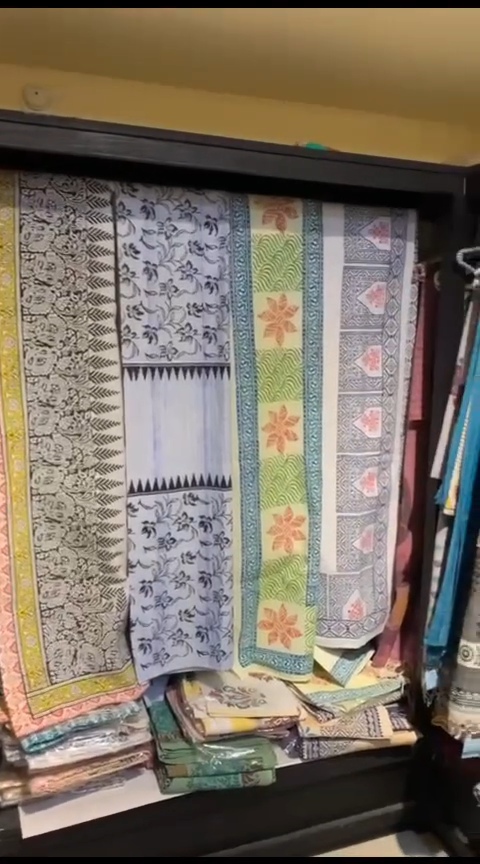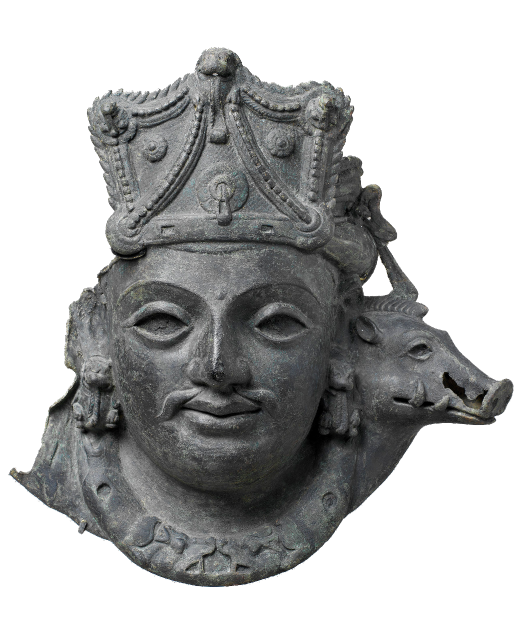PERSPECTIVES
The Humble Allure of the Chhapa Sari
With sunglasses perched on her nose and rocking a bold red lipstick, Arati, the protagonist of Satyajit Ray’s 1963 classic Mahanagar (Big City) rises from her humble background to discover her worth. In her new role, as a working woman, she commands respect; elegance personified in her delightfully crisp chhapa sari.
Chhapa, a colloquial term for printed cotton saris, once exemplified middle-class Bengali womanhood. Soft in texture, delicately decorated and pleasing to the eyes and the skin, chhapa saris were at once both luxurious and affordable. As a young India came into her own after independence, so did Indian women. Stepping out to join the workforce in increasing numbers, they ushered in a new era of feminine fashion, one rooted in tradition but confident and chic.
In Bengal, chhapa saris became the uniform of choice of the Bengali woman navigating the dual responsibilities of the domestic sphere and the professional domain. She stepped into the world outside in her crisply starched attire, confident that the garment would hold its structure despite the heat and humidity. At home, it mellowed into soft folds and a pliant drape, yet remaining secure in its role as the maternal care-giver’s garment. The end of the anchal, tucked into the waist, was often pulled out to offer assistance — a hand towel for the family, a key-holder, a coin pouch of sorts.
The chhapa could effortlessly transition from boardroom to bedroom with the amount of starch determining its role. When the prints faded and the fabric vehemently refused to hold structure, even with starch, it would be repurposed as a household cleaning cloth, treasured for its softness and absorbency.

Also called malmal or mul, borrowing its name from the legendary muslin cloth once favoured by Mughal royals, the chhapa, over time, became sartorially symbolic of Bengali women. So much so that the chhapa was used as a cinematic shorthand by filmmakers like Satyajit Ray and Aparna Sen to portray a certain class of urban, educated women in their films.
In 1991’s Aguntuk (The Stranger), Anila, played by Mamata Shankar, is an upper-middle class homemaker who is often seen in a perfectly pleated chhapa. Even when she is at home, not a fold is out of place. Who maintained her saris? She might have bundled them off to her trusted neighbourhood dhobi (traditional launderer) who would starch them to her exact preference before running hot coal iron to remove any evidence of a crease. Or maybe she made it a part of her household routine – saving rice water while cooking, diligently using it as maar (starch), followed by an extensive ritual of stretching them out while drying. They would be voluminous to wear at the start, but she’d know how to discipline the drape. On special occasions she may have had assistance with the pleats – from the husband, the son, or the domestic worker.
South Asia has a rich legacy of hand block printing, traditionally associated with the Chhipa community who migrated to various regions carrying their practice of chhapna (printing). Despite its long and glorious history of textiles, Bengal does not have any ancient printing custom. Chhapa literally means printed and is a relatively recent phenomenon.

Its story began in Serampore/Srirampur, a colony of Denmark from 1755 to 1845 located by the river Hooghly near Calcutta (now Kolkata). In 1799, Olav Bie, head of the Danish government of Serampore invited Christian missionaries William Carey, William Ward, and Joshua Marshman, who founded Serampore College. It is the first university of India in continuous operation, as well as a pioneering printing centre from where books were printed in over 40 Asian languages. In 1908, the College of Textile Technology was established in Serampore with a certificate course in weaving. Design innovation on saris was attempted later.
According to some sources, Chhipa weavers from Rajasthan and Gujarat settled in Serampore and introduced their craft to Bengal. With no definite tradition to uphold, artisans enjoyed artistic freedom. Even today, in nondescript workshops across West Bengal, they plan designs, create blocks out of seesham wood, and use them to imprint patterns on textiles. The popularisation of chemical dyes in the early 20th century made it easier to add varied colours without significantly adding to the cost.
Even though there is no defining print, chhapa saris have a distinctively Bengali aesthetic. Many of the popular prints are inspired from ritual rice paste floor drawings of Bengal, or alpona. Tribal motifs, as well as those inspired by other printing traditions like Mughal prints and kalamkari are also frequently used.
In the early 20th century, Bengal witnessed an artistic reformist movement led by stalwarts like Abanindranath Tagore, Nandalal Bose, and Jamini Roy. The Bengal School of Art has had a formidable impact on chhapa aesthetics. Script prints on textiles have been particularly favoured in the past decades as well, given the region’s affinity for the literary arts.

The allure of the chhapa rests not only on its design vocabulary. Its consistent popularity has also been due to the material used. Historically, Bengal had muslin cotton, often with exclusively woven jamdani or embroidered chikankari. In terms of cost and availability, it was reserved for the upper echelons of the society.
With the Industrial Revolution of the 18th century, mass-manufactured cotton textiles started to appear in the markets. Though they could not match the lightness and transparency of handwoven muslin, they were economical reproductions; an agreeable alternative that was accessible for the masses.
In 1818, the first cotton mill in India was set up at Fort Gloster in Hughli district near Calcutta. The Bowreah Mills was built for £200,000 and had 20,000 spindles and 100 looms. Initially, European workers taught machine-spinning to local staff. By the 1870s, it grew to 45,000 spindles. By then, India had 47 textile mills in operation.
Back in Serampore, Bangalakshmi cotton mill started in 1906 to boost the Swadeshi movement and was once the only manufacturer of mill-made dhuti (dhoti). Interestingly, preloved dhutis would often be sent for block printing and dying to chhapa workshops to be reborn as saris.
Though chhapa can also be made of handloom cotton and even silk, mill cotton ones dominate the modest sari shops found aplenty in Bengal, with the price starting from a few hundred rupees, even in this age of inflation.

In the past many decades, chhapa has been further democratised. Just like industrialisation of textile industry brought malmal to the middle class, advances in mechanical printing technology like screen prints and roller prints made chhapa accessible to the working class. Ikat-inspired on one day, bandhni on the next. The five days of Durga Puja became a fashionable exploration of colours and patterns, thanks to chhapa designs. Mass production reduced the cost further.
The domestic worker who once held down the pleats for her employer, could now bring freshly minted saris home. She no longer had to wonder how she would look in crisp chhapa saris worn by models and actresses on billboards. A quick shopping trip is all it took to lay claim to the same aesthetic and, more importantly, the same respectability.
Dr Pritha Dasmahapatra is an Indian textile enthusiast and an avid traveller. She runs the popular Instagram account @tiptopped that explores the history and the heritage of Indian textiles. Originally a doctor from Kolkata, she now practices medicine in London.




